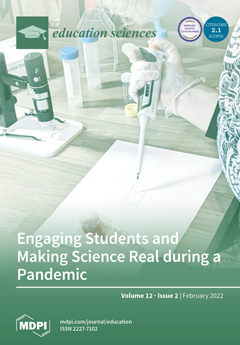Open AccessArticle
Teaching Mathematics with Technology: TPACK and Effective Teaching Practices
by
Christopher R. Rakes, Michele L. Stites, Robert N. Ronau, Sarah B. Bush, Molly H. Fisher, Farshid Safi, Siddhi Desai, Ashley Schmidt, Janet B. Andreasen, Jon Saderholm, Lisa Amick, Margaret J. Mohr-Schroeder and Julian Viera
Cited by 13 | Viewed by 4677
Abstract
This paper examines how 17 secondary mathematics teacher candidates (TCs) in four university teacher preparation programs implemented technology in their classrooms to teach for conceptual understanding in online, hybrid, and face to face classes during COVID-19. Using the Professional Development: Research, Implementation, and
[...] Read more.
This paper examines how 17 secondary mathematics teacher candidates (TCs) in four university teacher preparation programs implemented technology in their classrooms to teach for conceptual understanding in online, hybrid, and face to face classes during COVID-19. Using the Professional Development: Research, Implementation, and Evaluation (PrimeD) framework, TCs, classroom mentor teachers, field experience supervisors, and university faculty formed a Networked Improvement Community (NIC) to discuss a commonly agreed upon problem of practice and a change idea to implement in the classroom. Through Plan-Do-Study-Act cycles, participants documented their improvement efforts and refinements to the change idea and then reported back to the NIC at the subsequent monthly meeting. The Technology Pedagogical Content Knowledge framework (TPACK) and the TPACK levels rubric were used to examine how teacher candidates implemented technology for Mathematics conceptual understanding. The Mathematics Classroom Observation Protocol for Practices (MCOP
2) was used to further examine how effective mathematics teaching practices (e.g., student engagement) were implemented by TCs. MCOP
2 results indicated that TCs increased their use of effective mathematics teaching practices. However, growth in TPACK was not significant. A relationship between TPACK and MCOP
2 was not evident, indicating a potential need for explicit focus on using technology for mathematics conceptual understanding.
Full article
►▼
Show Figures





